A collection of spiders from Capertee Valley, NSW.
Huntsman spiders:
Holconia insignis (Sparassidae family) – These whopping stripy spiders come inside my house in summer and hide behind pictures and calendars. For a size reference, this male was photographed with a ruler and would be 17 cm across.

 male Holconia insignis, 17 cm across, emerging from behind a picture frame, 2 February 2019.
male Holconia insignis, 17 cm across, emerging from behind a picture frame, 2 February 2019.

female Holconia insignis, note smaller palps and larger body compared to male, this one was about 12 cm across. 27 February 2019.
Web Dasher spiders:
Corasoides species, Desidae family – It has taken me 20 years to work out what animal makes these webs on the ground! The webs are noticeable only after a heavy dew and only at certain times of the year. I had even wondered if they were caterpillar nests, before eventually photographing a spider occupant. (Photos taken after rain, 27 August 2018).


Look closely to see a hole in the middle of each web, which leads to a tunnel in the ground where the spider lives. The following diagram from the Australian Museum shows the structure of these webs. When a small insect lands on the web platform, the spider dashes out to grab it.


Female Corasoides species near the entrance to her burrow, 30 August 2018. Body length 5 mm.

Wolf Spiders
The Australian Arachnid group on Facebook could not identify this species nor genus. So it is Lycosidae family, unknown species, a wolf spider of the type that makes a lid for its burrow, (not all wolf spiders have lidded burrows). Wolf spiders have 360 degree sight due to having 4 eyes encircling the head, with another 4 eyes at the front. They are not poisonous. The burrow was 1 cm diameter. I photographed this female at her burrow entrance, 1 September 2018.



Trapdoor spiders
Arbantis species, Idiopidae family – I’ve seen these holes in the ground for many years and always wondered what lived within. Eventually I saw a scary-looking dark brown spider tidying up the webby entrance to her burrow. Despite the name, not all trapdoor species have a door on their burrow, and mine does not. This species can inflict a painful bite but are not poisonous. Some trapdoor species can live for over 40 years. I photographed this female 21 October 2018. The burrow entrance was 2 cm in diameter.




Jumping and Peacock Spiders
Maratus plumosus Plumed Peacock Spider, Salticidae family (Jumping Spiders) – The tiny Maratus spiders have been in the news a bit lately, with claims that even arachnaphobes will love them. The prettily patterned males do a display dance to attract females, who may either then eat them, or mate with them. Body length is about 5 mm, way too small to ever bite a human. I was delighted to find some Maratus on my dry woodland property. This one is a male, photographed in October 2016.



Hypoblemum villosum (Shaggy or Red-headed House Hopper), Salticidae family of Jumping Spiders – This female I found hopping around on river stones along Coco Creek. She had lots of friends, including a more strongly coloured red-headed male. The pattern on the female made me think of Fair Isle jumpers. Tiny size, maybe 5 mm. October 2016.
 female
female
 male
male
 male
male
Jotus species, Salticidae family of Jumping Spiders
I found this tiny female Jotus sp in my kitchen, 20 April 2019.



Orb-weaving Spiders
Argiope keyserlingi, St Andrew’s Cross Spider, family Araneinae. I photographed this beautifully-coloured, 7-legged specimen near Coco Creek, 27 January 2008. There are many variations of this type of spider.

Backobourkia heroine or brounii – Another orb-weaver, and what a wonderful name! This fearsome-looking spider built a messy web and had even messier living quarters. Photographed 25 October 2015, this large female was eating a native bee.




Austracantha minax, Australian Christmas Jewel Spider – Gasteracanthinae Spiny Orb-weaver family. This tiny spider is plump and round with colourful dots and splodges and six spines on its back. It is hard to tell the front from the back! Top view facing upwards, and underside view. This one is a female. (The male is smaller, darker and has no spines.) Photographed near Coco Creek, 14 May 2020.


Plebs eburnus, Eastern Enamelled Spider or Bush Orb Weaver. I found this small spider in its web, low to the ground. There are distinct patterns on the underside and the top of the abdomen. The web has vertical ‘stabilimentum’ which are the white zigzag lines in the orb web. This spider is a female and was photographed in nearby bushland, 5 September 2020.
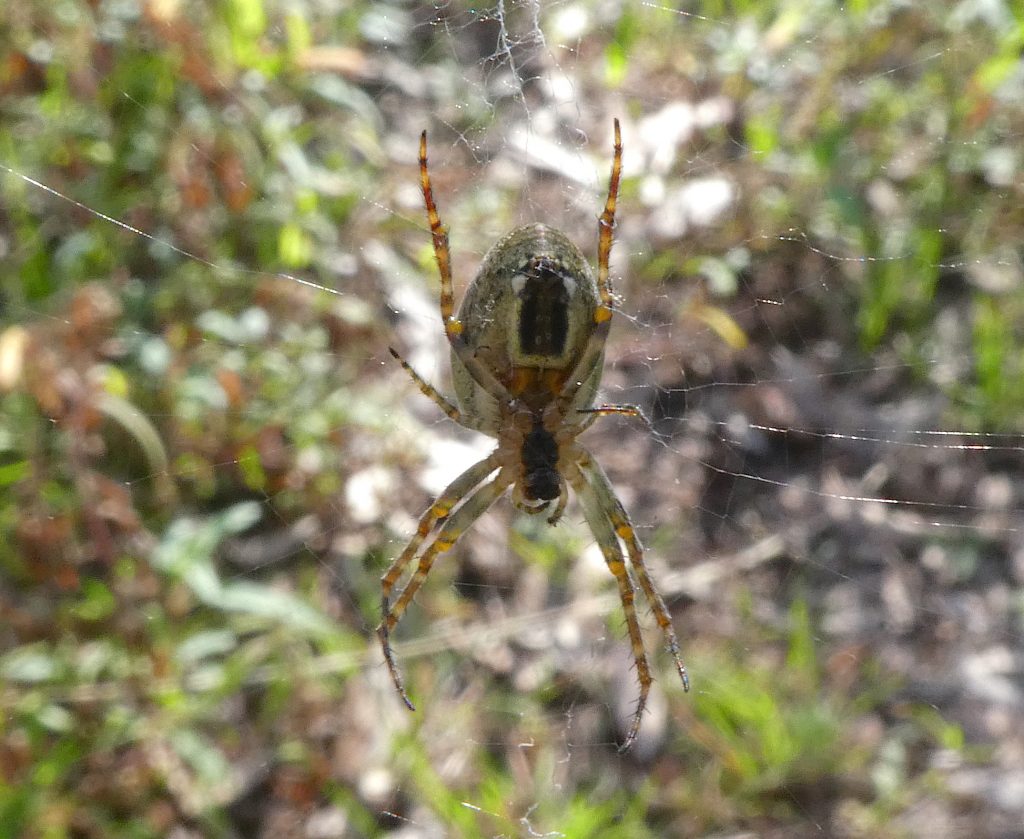
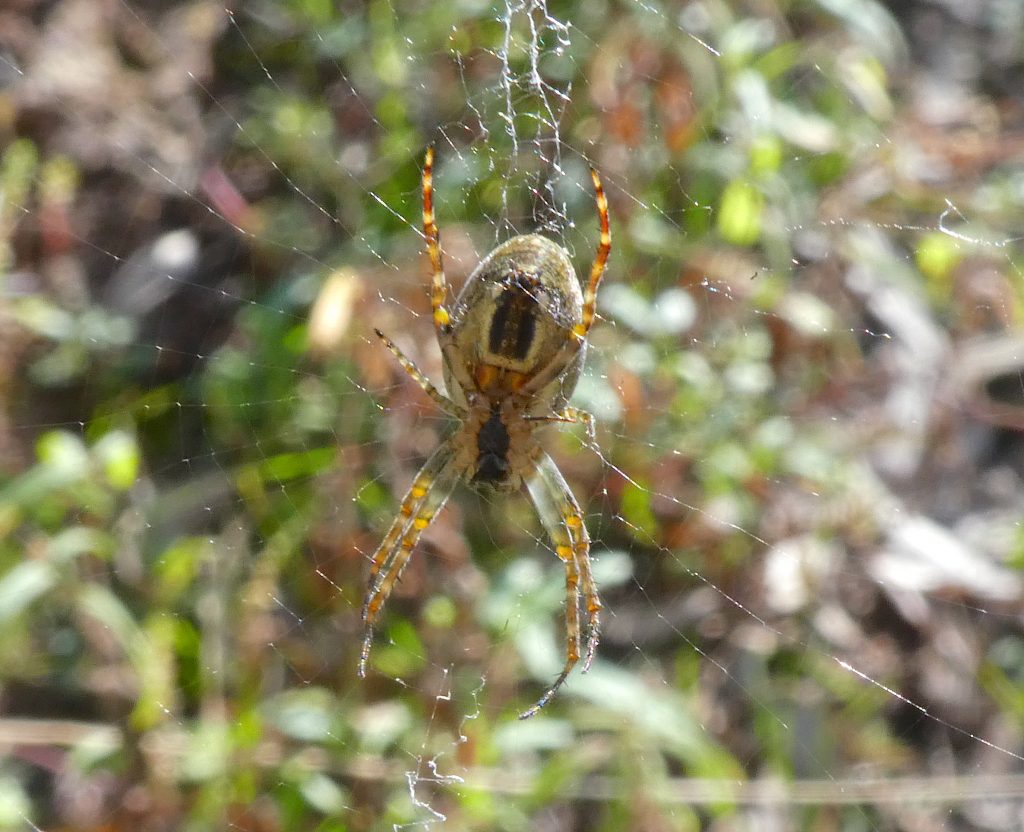
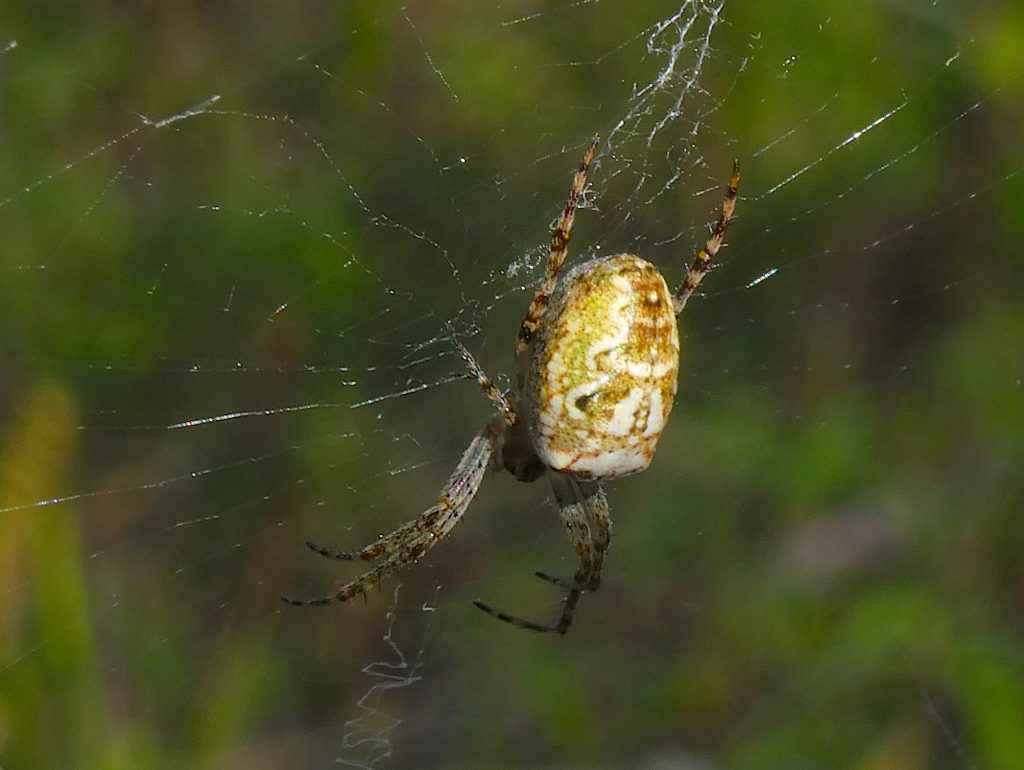
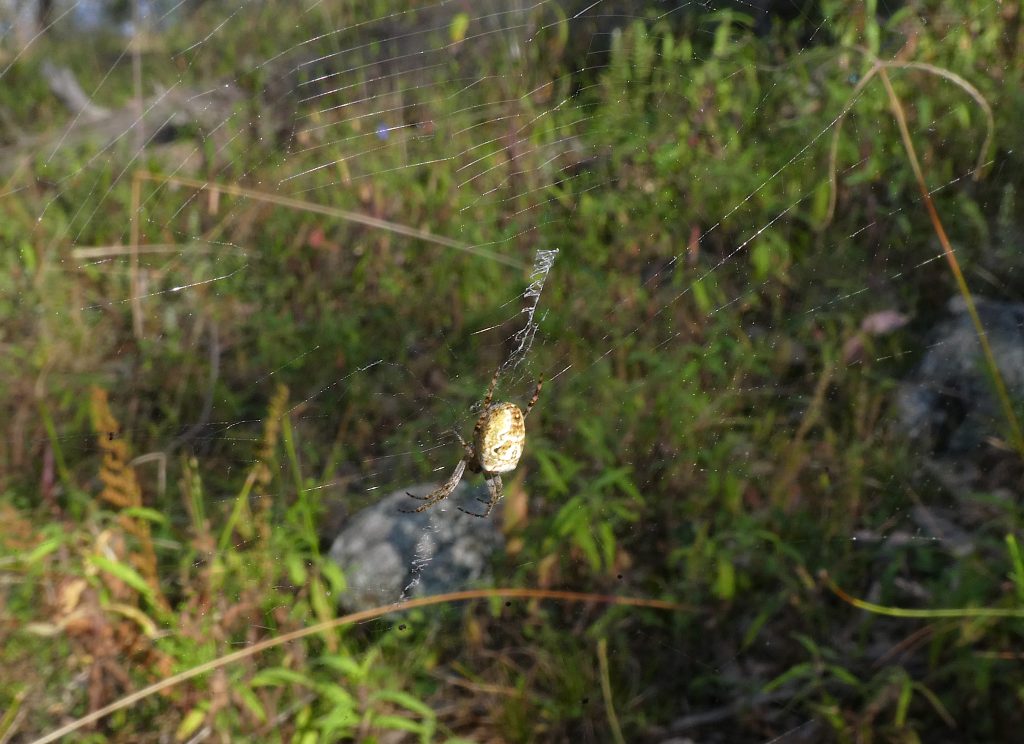
Phonognatha graeffei, Leaf Curling Spider. Usually hidden inside the leaf, this small spider, a female, made a rare appearance to do some housework. The male may co-habit, living at the other end of the same leaf. There are lots of these about at the moment, after a mild and rainy summer. Photographed 24 March 2021.
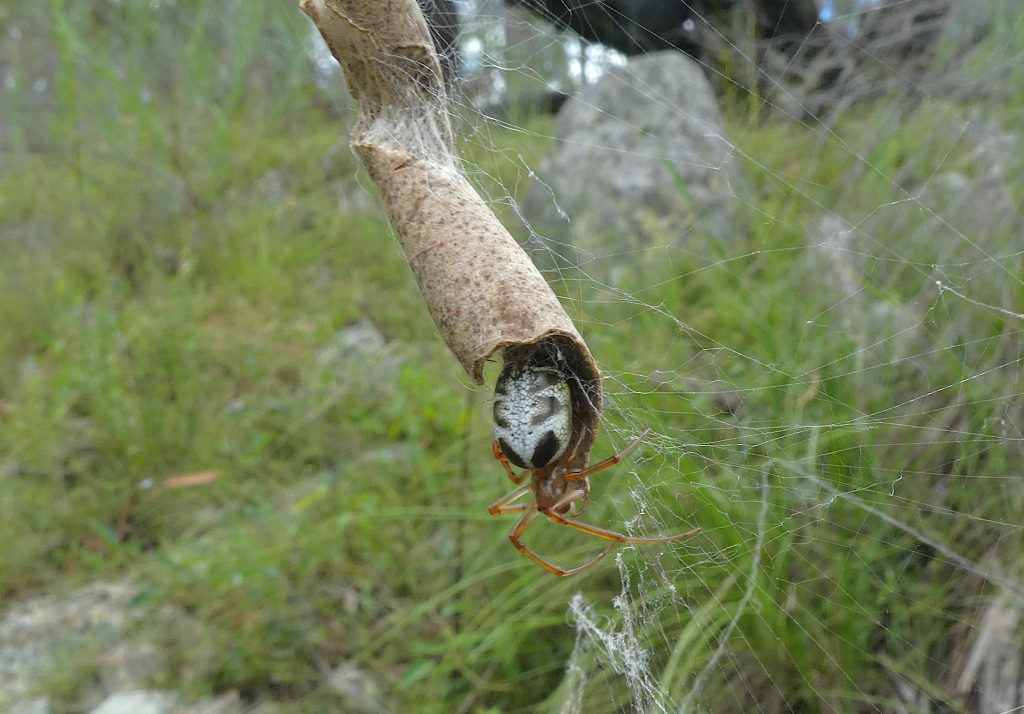
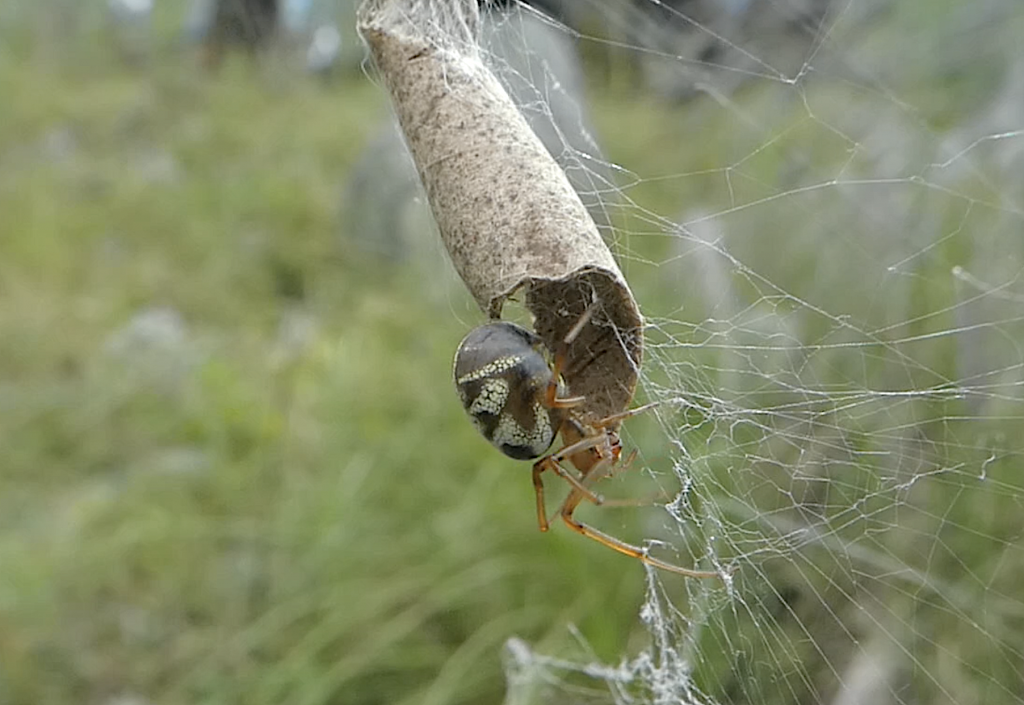
Comb-footed Spiders
Ariamnes colubrinus, Whip Spider, Theridiidae family
We found this peculiar-looking spider along Coco Creek on a Nature Conservation Trust walk, November 2012. Tiff had thought it was a long-jawed spider, but it turned out to be a Whip Spider.

Ant-eating spiders:
Habronestes species, Zodariidae family – This small fast-running ground spider is an ant-mimic that eats ants. It was about the size of a meat ant or perhaps a bit bigger and had yellow spots on its abdomen. I was lucky to get a sharp photo! 1 April 2019.

Crab Spiders:
Tharpyna species, Thomisidae family – So-called because they can run sideways, crab spiders are many and diverse and some of them can even change colour if they are waiting on a flower to ambush their prey. They all have eight eyes in two rows of four. This Tharpyna sp. was on a window pane of my house, and its large palps indicate it is a male. Body length was less than 10 mm. 30 September 2019.

Swift spiders:
Nyssus coloripes, Corinnidae family – small to medium sized spiders, and very fast runners! This one was on my back verandah, pausing, running, pausing. It was hard to get a photo! About the size of a ten cent piece, including legs. 1 April, 2020.

Prowling spiders:
Miturga gilva, Miturgidae family – spiders in this family shelter under logs and rocks and prowl about at night. This particular species makes tough, densely woven silk retreats which may hold a single egg sac which is then guarded. Eyes form two straight rows of tiny dots. I was moving some rocks when I found this one, and coaxed it out of the web with a grass stem. This female is missing two of its legs, with body length about 16 mm.




Another in the same family is a much smaller spider, Argoctenus sp. It has striped legs that look like pipe cleaners.


